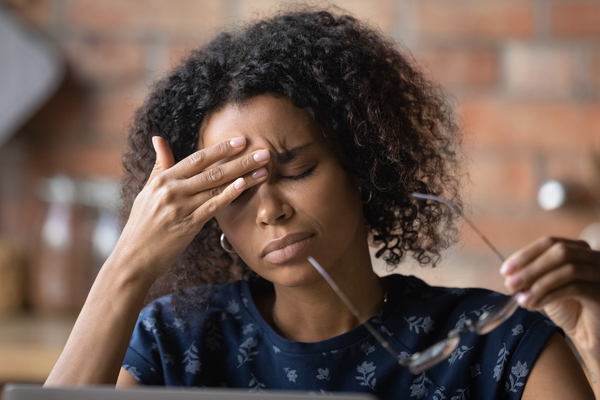Migraines are often confused with other types of headaches. And with more than 200 different headache types recognized by the International Classification of Headache Disorders, it’s easy to understand why!
When a headache strikes, finding fast relief may be the only thing on your mind. But knowing how to distinguish between migraines and other common types of headaches can help you manage and treat them more effectively.
Migraine Headaches
Migraine headaches are common, affecting 39 million Americans. They are believed to be caused by brain circuitry. Migraines can be triggered by many things, including:
• Stress
• Medications
• Hormones
• Caffeine
• Alcohol and tobacco
• Certain foods
• Lack of sleep
• Loud noises, strong smells, and bright lights
Phases and Symptoms
A migraine can have four phases; however, not everyone experiences every stage.
- Prodrome: This phase occurs a day or two before the headache. Its symptoms can include frequent yawning, fatigue, difficulty sleeping, difficulty concentrating, trouble speaking or reading, depression, irritability, muscle stiffness, food cravings, nausea, constipation, increased need to urinate, and sensitivity to light and sound.
- Aura: The second phase can last five to 60 minutes. Symptoms can include visual disturbances, temporary loss of sight, and numbness or tingling.
- Headache: The pain can be described as throbbing, drilling, burning, or stabbing. Other symptoms may include giddiness, mood changes, anxiety, insomnia, nasal congestion, neck pain or stiffness, nausea, vomiting, and sensitivity to light, smell, and sound. This phase can last four to 72 hours.
- Postdrome: This phase lasts 24 to 48 hours. Symptoms can include confusion, difficulty concentrating, trouble with comprehension, fatigue, mood changes, and intense joy.
Treatment and Prevention
Rescue medications can stop a migraine attack if they’re taken at the onset. Over-the-counter ibuprofen specifically for migraines is available, and doctors can provide stronger medications, such as triptans if needed. However, most migraine rescue medications can cause rebound headaches if they’re taken more than three times in one week. For those with four or more migraine days a month, doctors may suggest preventive medicines. Regular exercise, a healthy diet, good sleep, and self-relaxation techniques such as acupuncture and yoga may also help reduce the frequency and intensity of migraine headaches.
Other common types of headaches
Tension Headaches
Tension headaches feature dull aches and tightness or pressure, as opposed to the strong throbs or pulses of migraine headaches. They may cause soreness in the temples and tightness in the neck and shoulder muscles.
Over-the-counter medications, such as acetaminophen, aspirin, ibuprofen, and naproxen sodium, can help control tension headaches. Using a hot or cold compress on your head can also provide relief. A healthy lifestyle can help prevent this type of headache from happening. This includes eating a healthy diet, exercising, getting enough rest, and managing stress.
Sinus Headaches
Sinus headaches are caused by a buildup of pressure in your sinuses due to congestion and inflammation. They are primarily felt in your face, while migraine headaches can cause pain around the temples, high in the forehead, and in the back of the head. Both can cause runny noses, but migraine mucus is thin and clear, while sinus mucus is thick and discolored.
To get rid of a sinus headache, the cause of the inflammation needs to be treated. If it’s caused by allergies, an over-the-counter antihistamine or decongestant may provide relief. Using a humidifier and saline nasal spray can also be helpful. If the sinus inflammation is caused by a bacterial infection, a doctor may need to prescribe an antibiotic.
Cluster Headaches
Cluster headaches affect one side of the head and are very painful. While their exact cause is unknown, they do share many of the same triggers as migraines. But unlike migraines, cluster headaches come on suddenly with piercing pain. They usually also involve eye redness, tearing, or nasal congestion on the affected side. They last 30 to 90 minutes and can occur up to eight times a day.
- MORE ON HEALTH & WELLNESS
- The impact of PTSD on relationships
- How socioeconomic factors shape health outcomes in minority communities
- Understanding Menopause and Andropause
Fast-acting treatments for cluster headaches include oxygen and triptans, which are available to be taken by pill, nasal spray, or injection. Steroids and nerve blocks may also be an option. There is no cure for cluster headaches, but getting enough sleep and avoiding alcohol may lower their frequency. Doctors can also prescribe preventive medications to keep them at bay.
The Importance of Lifestyle Changes
While you may want to automatically reach for an over-the-counter pain medication when you have a headache, it’s important to avoid relying too heavily on a “magic pill.” Regular use of pain medications can sometimes cause rebound headaches when stopped, creating a vicious cycle. Instead, focus on lifestyle changes such as improving your diet, ensuring good sleep hygiene, and incorporating regular exercise into your routine. These adjustments can help reduce the frequency and severity of headaches, leading to a healthier and more comfortable life.



